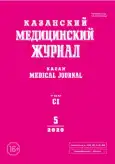Медико-социальные показатели репродуктивного потенциала женского населения региона на примере Республики Татарстан
- Авторы: Хабриев Р.У.1, Мингазова Э.Н.1,2,3, Шигабутдинова Т.Н.4,5, Садыкова Р.Н.6
-
Учреждения:
- Национальный научно-исследовательский институт общественного здоровья им. Н.А. Семашко
- Казанский государственный медицинский университет
- Российский национальный исследовательский медицинский университет им. Н.И. Пирогова
- Национальный научно-исследовательский институт общественного здоровья им. Н.А. Семашко, г. Москва, Россия
- Городская клиническая больница №7, г. Казань, Россия
- Первый Московский государственный медицинский университет им. И.М. Сеченова
- Выпуск: Том 101, № 5 (2020)
- Страницы: 719-726
- Тип: Социальная гигиена и организация здравоохранения
- URL: https://journal-vniispk.ru/kazanmedj/article/view/46498
- DOI: https://doi.org/10.17816/KMJ2020-719
- ID: 46498
Цитировать
Аннотация
Цель. Проанализировать динамические изменения медико-социальных показателей репродуктивного потенциала женского населения, маркёров тенденций в формировании медико-демографического процесса в регионе.
Методы. Исследование проведено на основе анализа литературных источников, определяющих общую тенденцию по демографической ситуации в стране, а также информации из статистических сборников Росстата и Минздрава России и Татарстана. В ходе исследования использованы аналитический и статистический методы (дескриптивная статистика, критерий Стьюдента, анализ трендов).
Результаты. Выявлено, что в динамике (1991–2017) уменьшился показатель плодовитости женщин, проживающих на селе (с 79,9 до 42,3 на 1000 женщин 15–49 лет; p <0,05). До 2014 г. показатель среди проживающих в сельской местности был выше аналогичного показателя среди горожанок. С 2015 г. тенденция сменилась на противоположную: среди городских женщин он стал бо́льшим, чем среди проживающих на селе, что коррелирует с уровнем рождаемости в городской и сельской местностях. Доля родившихся живыми за период 1991–2017 гг. у женщин раннего репродуктивного возраста (до 20 лет) уменьшилась среди горожанок с 11,3 до 3,7% (p <0,05), среди сельчанок с 10,0 до 5,8% (p <0,05); среди городских женщин возрастной группы 20–24 лет с 35,4 до 27,1% (p <0,05), среди сельских того же возраста с 40,9 до 34,2% (p <0,05). За наблюдаемый период доля родившихся живыми детей среди женщин старшей группы репродуктивного возраста увеличилась как среди жительниц городов, так и в сельской местности. Отмечено изменение в структуре родившихся по очерёдности рождения детей: в городской местности 55,9% приходилось на первого ребёнка, в сельской местности — 44,3%; на второго ребёнка — 35,1 и 34,2% соответственно; на третьего и более детей — 9 и 21,5%.
Вывод. Анализ медико-социальных показателей репродуктивного потенциала женского населения и маркёров тенденций в формировании медико-демографического процесса в регионе позволяет говорить о снижении уровня плодовитости (фертильности) женщин при росте показателя среднего возраста рожениц.
Полный текст
Открыть статью на сайте журналаОб авторах
Рамил Усманович Хабриев
Национальный научно-исследовательский институт общественного здоровья им. Н.А. Семашко
Автор, ответственный за переписку.
Email: institute@nriph.ru
Россия, г. Москва, Россия
Эльмира Нурисламовна Мингазова
Национальный научно-исследовательский институт общественного здоровья им. Н.А. Семашко; Казанский государственный медицинский университет; Российский национальный исследовательский медицинский университет им. Н.И. Пирогова
Email: institute@nriph.ru
Россия, г. Москва, Россия; г. Казань, Россия; г. Москва, Россия
Татьяна Николаевна Шигабутдинова
Национальный научно-исследовательский институт общественного здоровья им. Н.А. Семашко, г. Москва, Россия; Городская клиническая больница №7, г. Казань, Россия
Email: institute@nriph.ru
Россия, г. Москва, Россия; г. Казань, Россия
Ромина Наилевна Садыкова
Первый Московский государственный медицинский университет им. И.М. Сеченова
Email: institute@nriph.ru
Россия, г. Москва, Россия
Список литературы
- Послание Президента Федеральному собранию. http://www.kremlin.ru/events/president/news/62582 (дата обращения: 01.03.2020).
- Национальные проекты: ключевые цели и ожидаемые результаты. http://government.ru/projects/selection/741/35675/ (дата обращения: 01.03.2020).
- Яруллин А.Х., Карпухин Е.В., Мингазова Э.Н. Репродуктивно-демографические процессы в Республике Татарстан. М.: Медицина. 1998; 114 с.
- Атамбаева Р.М., Мингазова Э.Н. Современное состояние репродуктивно-демографического процесса в Кыргызской Республике. Казанский мед. ж. 2015; 96 (4): 587–593. doi: 10.17750/KMJ2015-587.
- Ясюкевич Ю.В. Репродуктивное поведение российских женщин, проживающих на территории Сибири. Междисциплинарные исследования в науке и образовании. 2012. http://www.mino.esrae.ru/157-613 (дата обращения: 20.02.2020).
- Цыбульская И.С., Низамова Э.Р. Проблемы формирования здоровья женщин-матерей и их потомства в современной России. Менеджер здравоохр. 2016; (7): 29–45.
- Мингазова Э.Н., Щепин В.О., Железова П.В., Садыкова Р.Н. Современные особенности рождаемости и смертности населения Центральной России. Пробл. социал. гигиены, здравоохр. и истории мед. 2019; 27 (5): 858–864. doi: 10.32687/0869-866X-2019-27-5-858-864.
- Блинов Д.С., Грачёва Т.С., Исламова М.Н., Чугунова Л.А. Проблемы репродуктивного здоровья женщин и способы повышения репродуктивного потенциала. Огарёв-online. 2016; (15): 10–18.
- Новосёлова Е.Н. Трансформация возрастного профиля рождаемости как фактор снижения репродуктивного потенциала населения России: медико-демографический аспект. Сб. статей VII Уральского демографического форума с международным участием «Динамика и инерционность воспроизводства населения и замещения поколений в России и СНГ». 2016; 244–249.
- Закоркина Н.А. Медико-демографические проблемы формирования репродуктивного потенциала населения Омской области за период с 2007 по 2017 гг. Социал. аспекты здоровья населения. 2019; 65 (5): 8.
Дополнительные файлы












